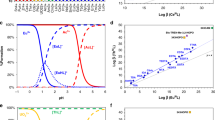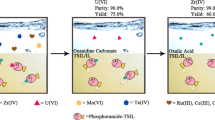Abstract
We report here an initial isolation study based upon the use of small uranium oxide particles dispersed in a soluble salt matrix to evaluate the relative recovery of fission products into acidic media. We further show that the macrostructures of the uranium microparticles are largely preserved, such that the bulk target material could be retained for additional irradiations or characterizations. Through this approach, fission products can be separated from the actinide-based target using low molarities of acid without the need to dissolve the actinide itself, reducing the amount of acidic waste. Extraction yields using two molarities of HCl and HNO3 are compared.








Similar content being viewed by others
References
Miller WH, Duval P, Jurisson SS, Robertson JD, Wall JD, Quinn TP, Volkert WA, Neumeyer GM (2005) Radiochemistry at the University of Missouri-Columbia: a joint venture with chemistry, nuclear engineering, molecular biology, biochemistry, and the Missouri University Research Reactor (MURR). J Radioanal Nucl Chem 263(1):131–136. https://doi.org/10.1007/s10967-005-0026-0
Malenfant RE (1981) Los Alamos critical assemblies facilities. Los Alamos Scientific Laboratory, Los Alamos
Medical Radioisotopes and Applications. https://radiochemistry.org/nuclearmedicine/frames/medical_radioisotopes/index.html. Accessed 27 Feb 2017
Gholamzadeh Z, Mirvakili SM, Davari A, Alizadeh M, Joz-Vaziri A (2017) Investigation of 99Mo potential production via UO2SO4 liquid target irradiation in a 5 MW nuclear research reactor. Nukleonika 62(1):37. https://doi.org/10.1515/nuka-2017-0006
Jaroszewicz J, Marcinkowska Z, Pytel K (2014) Production of fission product 99Mo using high-enriched uranium plates in polish nuclear research reactor MARIA: technology and neutronic analysis. Nukleonika 59(2):43. https://doi.org/10.2478/nuka-2014-0009
Butler RA (2008) Production of molybdenum 99 at the University of Missouri Research Reactor Center. In: Annual meeting proceedings of the Institute of Nuclear Materials Management, Nashville, TN, pp 462/461–462/465
Brewer RW, McLaughlin TP, Dean V (1999) Uranium-235 sphere reflected by normal uranium using flattop, vol 2. Nuclear Energy Agency
Ford GP, Norris AE (1975) Compliation of yields from neutron-induced fission of thorium-232, uranium-235, -236, neptunium-237, uranium-238, and plutonium-239 measured radiochemically at Los Alamos. Los Alamos Scientific Laboratory, Los Alamos
Selby HD, Mac Innes MR, Barr DW, Keksis AL, Meade RA, Burns CJ, Chadwick MB, Wallstrom TC (2010) Fission product data measured at Los Alamos for fission spectrum and thermal neutrons on 239Pu, 235U, 238U. Nucl Data Sheets 111(12):2891–2922. https://doi.org/10.1016/j.nds.2010.11.002
Bonamici CE, Hervig RL, Kinman WS (2017) Tracking radionuclide fractionation in the first atomic explosion using stable elements. Anal Chem 89:9877–9883
Choppin G, Liljenzin J-O, Rydberg J, Ekberg C (2013) Radiochemistry and nuclear chemistry, 4th edn. Academic Press, London
Fahey AJ, Zeissler CJ, Newbury DE, Davis J, Lindstrom RM (2010) Postdetonation nuclear debris for attribution. PNAS 107(47):20207–20212
Friedlander G, Kennedy JW, Macias ES, Miller JM (1981) Nuclear and radiochemistry, 3rd edn. Wiley, New York
Hutcheon ID, Grant PM, Moody KJ (2011) Nuclear forensic materials and methods. In: Vertes A, Nagy S, Klencsar Z, Lovas RG, Rosch F (eds) Handbook of nuclear chemistry. Springer, Boston
Mayer K, Wallenius M, Varga Z (2013) Nuclear forensic science: correlating measureable material parameters to the history of nuclear material. Chem Rev 113:884–900
Srinivasan B, Leonard RA, Aase S, Vandegrift GF, Moeridun A, Rauf A, Lubis H, Hardi A, Amini S, Nampira Y (1994) Processing of LEU targets for 99Mo production—dissolution of metal foils by nitric acid/sulfuric acid mixtures. In: 1995 International meeting on reduced enrichment for research and test reactors, Paris, France, 1994. https://doi.org/10.1017/cbo9781107415324.004
Krane KS (1988) Introductory nuclear physics. Wiley, USA
Lehto J (2010) Radiochemical separation methods. NKS Workshop on Radioanalytical Chemistry, IAEA, Denmark
Armbruster P, Münzenberg G (2012) An experimental paradigm opening the world of superheavy elements. Eur Phys J H 37(2):237–309. https://doi.org/10.1140/epjh/e2012-20046-7
Svirikhin AI, Gupta M, Yeremin AV, Izosimov IN, Isaev AV, Kuznetsov AN, Malyshev ON, Mullins S, Popeko AG, Sokol EA, Chelnokov ML, Chepigin VI (2015) Investigating neutron multiplicity during the spontaneous fission of short-lived isotopes (Z ≥ 100) using the VASSILISSA recoil separator. Bull Russ Acad Sci Phys 79(4):442–449. https://doi.org/10.3103/s1062873815040310
Hoffman DC, Lee DM (1999) Chemistry of the heaviest elements—one atom at a time. J Chem Educ 76(3):331. https://doi.org/10.1021/ed076p331
Berg GPA, Couder M, Moran MT, Smith K, Wiescher M, Schatz H, Hager U, Wrede C, Montes F, Perdikakis G, Wu X, Zeller A, Smith MS, Bardayan DW, Chipps KA, Pain SD, Blackmon J, Greife U, Rehm KE, Janssens RVF (2018) Design of SECAR a recoil mass separator for astrophysical capture reactions with radioactive beams. Nucl Instrum Methods Phys Res A 877:87–103. https://doi.org/10.1016/j.nima.2017.08.048
Lawin H, Eidens J, Borgs JW, Fabbri R, Grüter JW, Joswig G, Khan TA, Lauppe WD, Sadler G, Selič HA, Shaanan M, Sistemich K, Armbruster P (1976) The Jülich on-line separator for fission products “Josef”. Nucl Instrum Methods 137(1):103–117. https://doi.org/10.1016/0029-554X(76)90255-X
Whapham AD, Makin MJ (1962) The nature of fission fragment tracks in uranium dioxide. Philos Mag J Theor Exp Appl Phys 7(81):1441–1455. https://doi.org/10.1080/14786436208213286
Leshuk T, Krishnakumar H, Gu F (2015) Size-tunable Fe3O4 spherical nanoclusters through a one-pot hydrothermal synthesis. J Nanosci Nanotechnol 15(7):5378–5383
Onoda H, Yamaguchi T (2014) pH-controlled hydrothermal synthesis of titanium phosphates and their powder properties. J Adv Ceram 3(4):326–331
Niu H, Xie X, Wu X, An X, Chen S (2013) Synthesis and characterization of a-Ni(OH)2. Cailiao Daobao 27(6b):31
Choi BH, Park S-A, Park BK, Chun HH, Kim Y-T (2013) Controlled synthesis of La1−xSrxCrO3 nanoparticles by hydrothermal method with nonionic surfactant and their ORR activity in alkaline medium. Mater Res Bull 48(10):3651–3656. https://doi.org/10.1016/j.materresbull.2013.04.084
Cantos PM, Frisch M, Cahill CL (2010) Inorg Chem Commun 13:1036
Borkowski L, Cahill CL (2006) Cryst Growth Des 6:2248
Frisch M, Cahill CL (2006) Synthesis, structure and fluorescent studies of novel uranium coordination polymers in the pyridinedicarboxylic acid system. Dalton Trans 39:4679–4690
Gibson MA, Briggs MH, Sanzi JL, Brace MH (2013) Heat pipe powered stirling conversion for the Demonstration Using Flattop Fission (DUFF) Test. Cleveland, Ohio
Hayes DK, Myers WL (2012) NCERC capabilities and status July 2012. In: Institute of nuclear materials management 53rd annual meeting, Orlando, FL
Loaiza D, Gehman D (2006) End of an era for the Los Alamos Critical Experiments Facility: history of critical assemblies and experiments (1946–2004). Ann Nucl Energy 33(17):1339–1359. https://doi.org/10.1016/j.anucene.2006.09.009
Gibson MA, Briggs MH, Sanzi JL, Brace MH (2013) Heat pipe powered stirling conversion for the Demonstration Using Flattop Fission (DUFF) Test. National Aeronautics and Space Administration Glenn Research Center, Cleveland
Hayes DK, Myers WL (2012) National Criticality Experiments Research Center: capability and status. In: Institute of nuclear materials management 53rd annual meeting, Orlando, FL, USA
Loaiza D, Gehman D (2006) End of an Era for the Los Alamos Critical Experimental Facility: history of critical assemblies and experiments (1946–2004). Ann Nucl Energy 33:1339–1359
Malenfant RE (1981) Los Alamos Critical Assemblies Facility. Los Alamos Scientific Laboratory
Aldrich S (2017) Safety data sheet potassium bromide. Sigma Aldrich
Labrecque C, Lebed PJ, Larivière D (2016) Isotopic signature of selected lanthanides for nuclear activities profiling using cloud point extraction and ICP-MS/MS. J Environ Radioact 155–156:15–22. https://doi.org/10.1016/j.jenvrad.2016.02.002
Kuganathan N, Arya AK, Rushton MJD, Grimes RW (2018) Trapping of volatile fission products by C60. Carbon 132:477–485. https://doi.org/10.1016/j.carbon.2018.02.098
Bray LA, Burger LL, Morgan LG, Baldwin DL (1983) Thermal release of volatile fission products from irradiated nuclear fuel. Pacific Northwest National Laboratory
Fahey AJ, Zeissler CJ, Newbury DE, Davis J, Lindstrom RM (2010) Postdetonation nuclear debris for attribution. Proc Natl Acad Sci 107(47):20207–20212. https://doi.org/10.1073/pnas.1010631107
Wu D, Liu P, Wang T, Chen X, Yang L, Jia D (2018) Amino acid-assisted synthesis of Fe2O3/nitrogen doped graphene hydrogels as high performance electrode material. Electrochim Acta 283:1858–1870. https://doi.org/10.1016/j.electacta.2018.07.103
Wu X, Liu J, Chen Z, Yang Q, Li C, Lu G, Wang L (2012) Amino acid assisted synthesis of mesoporous TiO2 nanocrystals for high performance dye-sensitized solar cells. J Mater Chem 22(21):10438–10440. https://doi.org/10.1039/C2JM16762J
Whapham AD, Makin MJ (1962) The nature of fission fragment tracks in uranium dioxide. Philos Mag 7(81):1441. https://doi.org/10.1080/14786436208213286
Whapham AD, Sheldon BE (1965) Radiation damage in uranium dioxide. Philos Mag J Theor Exp Appl Phys 12(120):1179–1192. https://doi.org/10.1080/14786436508228669
Srinivasan B, Leonard RA, Aase S, Vandegrift GF, Moeridun, Rauf AA, Lubis H, Hardi A, Amini S, Nampira Y (1994) Processing of LEU targets for Mo-99 production–disolution of metal foils by nitric acid/sulfuric acid mixtures. In: 1995 International meeting on reduced enrichment for research and test reactors, Paris, France
Snelgrove JL, Hofman GL, Wiencek TC, Wu CT, Vandegrift GF, Aase S, Buchholz BA, Dong DJ, Leonard RA, Srinivasan B, Wu D, Suripto A, Aliluddin Z (1994) Development and processing of LEU targets for Mo-99 production—overview of the ANL program. In: 1995 International meeting on reduced enrichment for research and test reactors, Paris, France, September 18–21 1994, Schenectady, NY
Baum EM, Ernesti MC, Knox HD, Miller TR, Watson AM, Travis SD (2009) Nuclides and isotopes: chart of the nuclides. Bechtel Marine Propulsion Corporation, Richmond
Acknowledgements
We would like to acknowledge Dr. T. Bredeweg (LANL) for provision of the sample holders, Dr. T. Hartmann (UNLV) for the p-XRD analysis, Dr. R. Sudowe (CSU), Dr. W. Kerlin (UNLV), Dr. L. Boron-Brenner (UNLV), J. Bertoia (UNLV), T. Low (UNLV), R. Springs (UNLV), and Dr. D. Lowe (Varex) for their help with gamma spectroscopy. For financial support of this work, we acknowledge the LANL G. T. Seaborg Institute for Transactinium Science (graduate funding to JMD), and the Domestic Nuclear Detection Office under competitively awarded contract IAA: HSHQDC-16-X-00088 (post-doctoral funding to JMD). Los Alamos National Laboratory is operated by Triad National Security, LLC, for the National Nuclear Security Administration for the U.S. Department of Energy (Contract DE-SOL-0011206). This material is based upon work supported by the U.S. Department of Homeland Security under Grant Award Number, 2012-DN-130-NF0001. The views and conclusions contained in this document are those of the authors and should not be interpreted as representing the official policies, either expressed or implied, of the U.S. Department of Homeland Security. We also acknowledge the Development of a Synthetic Debris for Nuclear Forensics, Prime Contract No. DE-AC52-06NA25946, Subcontract No. 104777 Task Order 41. LA-UR-18-24296.
Author information
Authors and Affiliations
Corresponding author
Ethics declarations
Conflict of interest
The authors declare that they have no competing interest.
Additional information
Publisher's Note
Springer Nature remains neutral with regard to jurisdictional claims in published maps and institutional affiliations.
Electronic supplementary material
Below is the link to the electronic supplementary material.
10967_2019_6433_MOESM1_ESM.docx
The Supplementary Information, including the UO2 p-XRD pattern, a simplified separation scheme, gamma spectra, count data for all extractions, and the total percent extraction for each isotope is available free of charge. LA-UR-18-25912. (DOCX 591 kb)
Rights and permissions
About this article
Cite this article
Dorhout, J.M., Wilkerson, M.P. & Czerwinski, K.R. A UO2-based salt target for rapid isolation of fission products. J Radioanal Nucl Chem 319, 1291–1300 (2019). https://doi.org/10.1007/s10967-019-06433-9
Received:
Published:
Issue Date:
DOI: https://doi.org/10.1007/s10967-019-06433-9




